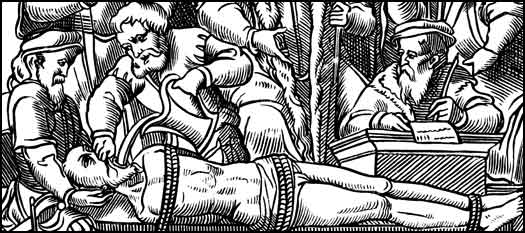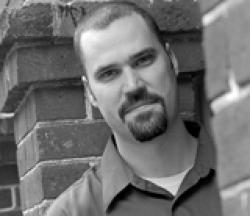
- “The Water Torture” from Joost Damhouder’s Praxis Rerum Criminalium, 1556. (The Stapleton Collection / The Bridgeman Art Library).
In March 2007, the US Defense Department released the transcript of Khalid Sheikh Mohammed’s testimony before a secret tribunal at Guantánamo. According to the text, Mohammed admitted, “I was responsible for the 9/11 operation, from A to Z.” He also confessed to planning the 1993 World Trade Center bombing; Richard Reid’s failed shoe bombing; the 2002 Bali nightclub bombings; and the horrific murder of Wall Street Journal reporter Daniel Pearl. The confession was presented as a victory for the intelligence community and a conclusion to many longstanding investigations.
But there were troubling inconsistencies. Special Agent Randall Bennett, former head of security for the US consulate in Karachi, told the New Yorker that he had personally interviewed all of the convicted accomplices in the Daniel Pearl case and Mohammed’s name “never came up.” Just as troubling, the 1993 World Trade Center bombing was plotted and carried out by Mohammed’s nephew Ramzi Yousef—a fact which may have granted him access to inside information—but there is no evidence to suggest that Mohammed was involved. So why would he admit to crimes he hadn’t committed?
One possible answer: as early as 2004, the Washington Post reported, “Khalid Sheikh Mohammed was subject to ‘water boarding.’” The technique involves strapping a person to a table, covering his mouth and nose with a cloth, and pouring water over the cloth, until the subject begins to inhale water and drown. There’s nothing new about this method. It dates back at least as far as the Spanish inquisition—when it was known simply as tortura del agua. It was used by Dutch traders in the seventeenth century in the East Indies and was finally banned by most Western countries during the Enlightenment.
In this country, Major Edwin Glenn was court-martialed and sentenced to ten years hard labor in 1901 for water boarding a prisoner in the Philippines during the Spanish-American War. The US officially outlawed the practice after World War II, because it had been used against Allied troops by the Gestapo and the Japanese Kempeitai. Indeed, eight Kempeitai officers were executed for water boarding British prisoners, and Japanese officer Yukio Asano was convicted by an Allied court of war crimes in 1947 for, among other things, water boarding John Henry Burton, a US civilian.
“Asano was sentenced to fifteen years of hard labor,” Senator Edward Kennedy said recently on the Senate floor. Nevertheless, Alberto Gonzales, just days after his confirmation as attorney general in February 2005, issued secret authorization to CIA Director George Tenet to employ “enhanced interrogation techniques,” including water boarding.
When Scott Pelley raised the issue with Tenet on 60 Minutes in May 2007, he replied, “We don’t torture people. Let me say that again to you, we don’t torture people. Okay?”
“Come on, George,” Pelley said. “Khalid Sheikh Mohammed?”
“We don’t torture people,” he insisted.
“Water boarding?”
“We do not—” Here Tenet stopped short, “I don’t talk about techniques.”
So it was that last October, under the glaring lights of his Senate confirmation hearing, Michael B. Mukasey, President Bush’s nominee to replace Gonzales as attorney general, waited, blinking, as Senator Sheldon Whitehouse of Rhode Island, rephrased his question as clearly as possible: “Do you have an opinion on whether water boarding, which is the practice of putting somebody in a reclining position, strapping them done, putting cloth over their faces and pouring water over the cloth to simulate the feeling of drowning—is that constitutional?”
“If it amounts to torture,” Mukasey replied, “it is not constitutional.”
If—as if any question persisted. John McCain, who should know, has been clear that water boarding is torture, telling the New York Times: “All I can say is that it was used in the Spanish Inquisition, it was used in Pol Pot’s genocide in Cambodia, and there are reports that it is being used against Buddhist monks today.” Regardless of which side of the political aisle you sit on, are these the groups we, as Americans, want to be identified with?
This issue of VQR takes up these questions in great depth and at considerable length. The discussion begins in Ramadi, Iraq, and in Herat and Kabul, Afghanistan. Neil Shea and David J. Morris examine what Ramadi was just a year ago and the remarkable turnaround that has occurred now that the military has taken an active role in working with local tribes. Nicholas Schmidle and J. Malcolm Garcia, however, paint a very different picture of Afghanistan, where the attitude toward Americans is souring, the result of continued American air raids and resurgent influence of the Taliban.
With this in mind, Jane Hirshfield asks the pressing question of how to foster mutual cultural understanding when the “choice is either madness or softening, either mindless slaughter or replacing the concept of enemy with the knowledge that the father of the person we have killed could have been our own father.” To that end, we also present the work of Daniel Heyman and Fernando Botero, two artists deeply moved by the reports of Abu Ghraib. Heyman sat with former Abu Ghraib prisoners, sketching their portraits and transcribing their testimony. Botero connected the suffering in the now infamous photographs with torture endured as a result of the drug wars in his native Colombia. Cleverly, he has maintained the style of his paintings such as “Massacre in Colombia,” so that at first impression, the violence seems South American, foreign, decidedly the work of some distant other, but then suddenly we recognize the postures, the setting. The invisible torturers are us.
What to do about this comes in a twin response. In a previously untranslated essay by Roberto Bolaño, the famed Chilean author, recounts the story of a friend who discovered that a government safe house for writers under Pinochet was secretly being used for torture. That the writers chose not to speak out, that they continued to hold their salons upstairs while in the basement their countrymen were subjected to electric cattle prods, is utterly unacceptable to Bolaño. Either the writer speaks out against atrocity, or tacitly endorses it.
The writer Ryszard Kapuscinski, who died a year ago this January, courageously chose the path of speaking out. In our symposium in Kapuscinski’s honor, acclaimed filmmaker Werner Herzog remembers with awe how his writer friend accepted incarceration and torture, once finding himself locked in a cell while guards filled the floor with poisonous snakes. Salman Rushdie pays tribute to Kapuscinski’s bravery in the face of public pressure (“as someone whose work has occasionally led to protest, I’m something of a connoisseur of the form”), and Breyten Breytenbach, himself held for seven years for treason for his opposition to apartheid in his home country of South Africa, writes in tribute to Kapuscinski: “Listen: you must continue traveling because the earth needs to be discovered and remembered again and again, cyclically, creatively, with her seasons and her sounds, with the warm breath of hospitality, with the healing touch of strangeness . . . lest it become cold and impenetrable—a barren place of power and politics.”
This is my hope for this issue: that, though we turn our gaze directly onto the darkest elements of life at a particularly dark moment in our history, we may find hope in the shining compassion and unwavering commitment of the writers collected between these covers. Remember as you read that these voices have endured imprisonment, lived under fatwa, been held at gunpoint, nearly been blown apart by roadside bombs—all in service of their art. They have sacrificed so much to witness the world as it is and risk still more by daring to imagine it better.








